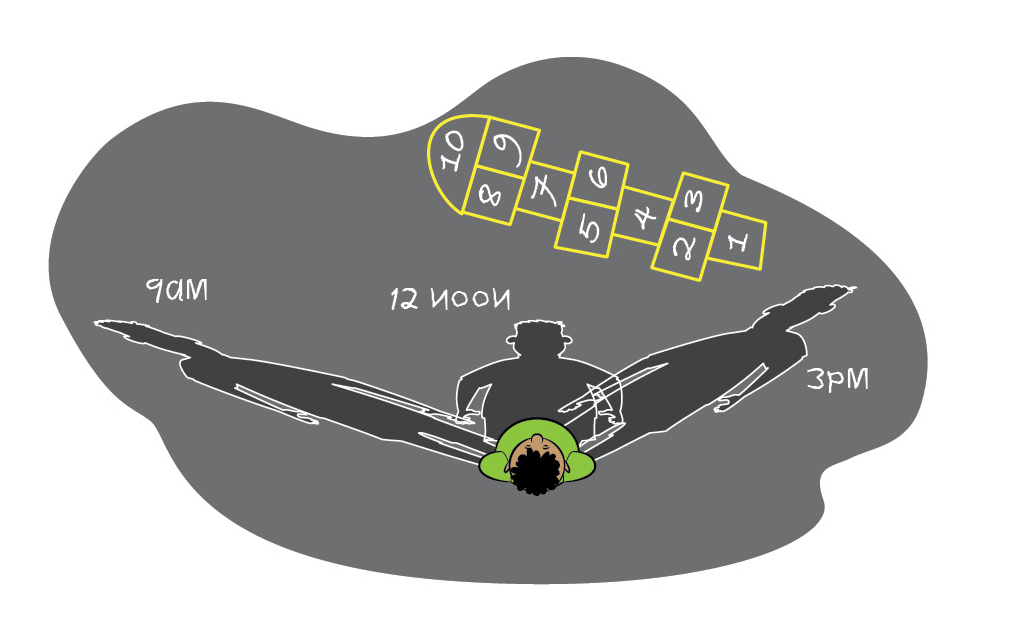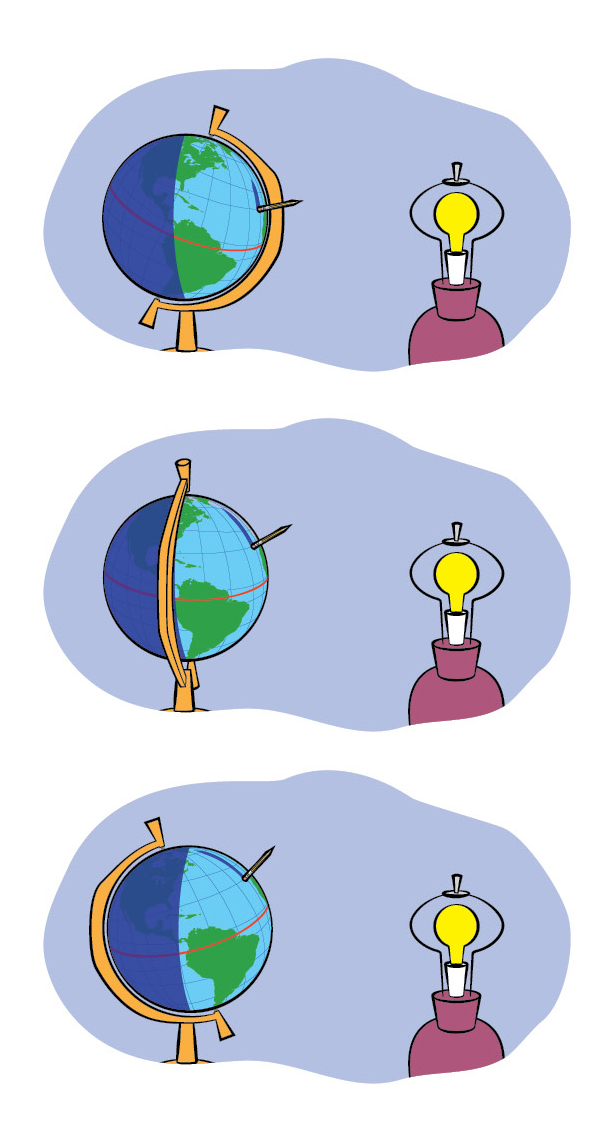science 101
Q: Do You Have an Activity for Daily and Seasonal Patterns and Motions of Earth?
Science and Children—November/December 2022 (Volume 60, Issue 2)
By Matt Bobrowsky

A: I have something that can work for any grade level, but of course the fifth graders will be able to delve deeper than the first graders. Beginning in first grade, students should start learning to use observations of the Sun, Moon, and stars to describe patterns. Once they know about those patterns, they can do something more—something that we tend to take for granted but is really quite amazing: they can make fairly good predictions.
Perhaps the most basic daily pattern in nature is the motion of the Sun, with its daily rising, moving across the sky, and setting. Some students might not be aware that the Sun appears to move across the sky over the course of the day, and some who do know that might not know the reason for it. First, let’s review a few things about shadows.
Part 1: Investigate Shadow Length
You can do this as a demonstration, or have your students do this in groups, with each group having a pencil and a flashlight. One student holds the pencil on a desk or table, pointed straight up. Another student shines a flashlight toward the pencil so that the shadow of the pencil can be observed. See how the length of the shadow changes as the flashlight is raised or lowered (see Figure 1). As students try this out, ask, “Where was the flashlight when the shadow of the pencil was shortest?” (high up, shining down toward the pencil) “Where was the flashlight when the shadow was longest?” (rather low) “Was any group able to make the shadow completely disappear? Where was the flashlight then?” (directly over the pencil, shining straight down)

When the light shines from a lower angle, the shadow is longer, and when the light shines from a higher angle, the shadow is shorter.
More questions to ask: “Does the pencil’s shadow point toward or away from the side that the flashlight is on?” (away) “What happens to the shadow if you move the flashlight sideways?” (The shadow moves sideways.) “Have you ever seen your shadow looking very short or very long? When? Why was it short or long? (Your shadow is short when the Sun is high in the sky. Your shadow is long when the Sun is low in the sky.)
Part 2: Observing Daily Movement of the Sun
Students can use the same idea as the pencil and flashlight to see how their shadow changes over the course of the day. This needs to be done on a sunny day. The best place to do this is on a paved area, where one can draw on the ground with chalk. If there’s no pavement you can use, it is possible to do this on grass; you’ll just have to be a bit creative when marking the outline of the shadows. This can be done just once with the entire class watching, or, better, each group of students can do it for themselves.
Step 1: For each group, one student (say her name is Jada), stands in one spot—like the pencil—and another student traces with the chalk on the ground around Jada’s shoes. It’s important to mark that spot, because we will be returning to it later in the day. Then another student can use the chalk to trace around Jada’s shadow. Write the time next to the shadow. For older students who can use a ruler, yardstick, or tape measure, have them measure the length of the shadow. Everybody can then go back inside and record what happened. Younger students might just draw a picture of Jada and her shadow, whereas older students can add the additional information—time and length of shadow.
Steps 2+: Repeat Step 1 every two or three hours that day. At the end of the day, everyone should have copied the chalk picture into their notebooks—a picture that looks something like the one in Figure 2. Discuss it. Ask, “What changes did you observe with the shadow?” (It moved to the right [or clockwise] and its length changed.) “Why did it move to the right?” (The Sun moved across the sky, like when you moved the flashlight to the right.) “Why did the length of the shadow change?” (The Sun appeared higher or lower in the sky.) If you try this activity again the next day or the day after, students should get similar results. They might conclude that it’s the same every day. Over short periods of time, like a week, that’s pretty accurate. However, over months, they can see that there are gradual changes occurring.

At different times of the day, the Sun will be in different places in the sky, making the student’s shadow different lengths and extending in different directions.
Part 3: Observing Seasonal Changes of the Sun’s location in the Sky
Repeat Step 2 every few months. The main thing to notice is that, at the same time of day, the lengths of the shadows change with the season. In the summer, the Sun gets higher in the sky (but never directly overhead; see the Misconception Alert), so shadows get shorter. In the winter, the Sun appears lower in the sky, so the shadow at, say, noon is longer in the winter than in the summer (see Figure 3).

As the Earth’s tilt relative to the Sun changes throughout the year, the Sun will appear higher or lower in the sky, making shadows appear shorter or longer at different times of the year.
To do the comparison over many months, you and the students will need to keep careful track of the drawings and data from months earlier. Maybe keep all this on a “science shelf”?
The Most Important Parts of Science: Explanations and Predictability
One of the main goals of science is to find explanations for what we observe. Science is not about memorizing facts but understanding why things are the way they are (seeking explanations.) In this case, we first observed that the Sun appears to move across the sky—as evidenced by the moving shadow—but why does the Sun appear to move across the sky? A thousand years ago, many people would have just assumed that the Sun (and stars) are circling, or revolving, around Earth. Today, we know that is not the case, that it is Earth that is revolving around the Sun. However, Earth’s revolution around the Sun is not why the Sun appears to move across the sky over the course of the day. The apparent movement of the Sun (and other celestial objects) across the sky over the course of the day is due to the spinning, or rotation, of Earth.
A good analogy is when you’re on a merry-go-round, and, as it’s rotating, you look outward, and it looks like trees and buildings are moving by in front of you. Of course, it’s really you that’s moving (see Figure 4). Similarly, we are on a giant “merry-go-round” we call Earth, and as it spins, we see things like the Sun appear to be moving past us.

The apparent motion of celestial objects due to the rotation of Earth can be compared to watching things appear to pass by in front of you when you’re on a merry-go-round.
How do we explain the seasonal change in shadow length? Earth’s axis of rotation maintains an approximately constant tilt throughout the year (see Figure 5). This means that the Northern Hemisphere is tilted a bit toward the Sun when Earth is on one side of the Sun (around June), and it is tilted a bit away from the Sun when Earth is on the other side of the Sun (around December). Caution: This does not cause a significant change in our distance from the Sun; the reason we have seasons has nothing to do with our distance from the Sun. For more about this, see the link to the March 2020 Science 101 column under Online Resources.

Earth maintains a constant 23.5° tilt as it revolves around the Sun. This can be shown (a) in a diagram or (b) by moving an “Earth ball” around a light bulb representing the Sun.
When the Northern Hemisphere is tilted toward the Sun, the Sun appears higher in the sky, and shadows are shorter. When the Northern Hemisphere is tilted away from the Sun, the Sun appears lower in the sky, and shadows are longer—recall Figure 3.
To summarize, the Sun (and Moon and other objects) appear to move across the sky each day due to our motion on a spinning, or rotating, Earth. The tilt of Earth causes the Sun to appear higher in the sky (in the middle of the day) in the summer compared to in winter. Therefore, by understanding the motions of Earth, we can account for the movement and changing length of shadows.
Quick extension: Can we now understand why sundials work the way they do?
Longer extension for older students: Discuss the cardinal directions (north, south, east, and west) and why they are defined the way they are. Earth’s axis of rotation defines the North Pole and South Pole, and hence the directions north and south. (Caution: Many people mistakenly think that “north” means straight up. It doesn’t. Think of it as the [horizontal] direction you’d have to travel to reach the North Pole.) Earth rotates from west to east. That is why the Sun appears to rise somewhere near the east and appears to set somewhere near the west. You can demonstrate this with your globe and a light. For those of us in the Northern Hemisphere, around noon the Sun appears in the south. Therefore, around noon, shadows point north. Knowing this provides a handy way of finding your directions.
Predictability
One amazing thing about science is its ability to make accurate predictions. For example, I can tell you—to the exact minute—what time the Sun will rise on this date 20 years from now. “Psychics” can’t do this, and astrologers can’t do this. Only scientists, like astronomers, can do this. Let’s see how your young scientists can do at making predictions. Ask them, “How long do you think your shadow will be tomorrow at 9 a.m.? Do you think the length of your shadow will be different at noon? Will it be shorter or longer?” They can then confirm that they are indeed able to make accurate scientific predictions based on the patterns they observed. They are doing science!
One last idea: You can start this lesson with a riddle: What’s bigger than you but doesn’t weigh anything? Answer: your shadow! (Technical note: The length of your shadow will be greater than your height when the Sun is less than 45° high—halfway up—in the sky.)
Never stop learning.
Online Resources
Science 101: Using Models to Learn About the Seasons
https://www.nsta.org/science-and-children/science-and-children-march-2020/q-what-are-some-astronomical-concepts-we-can
Misconception Alert
Many people mistakenly think that, at noon, the Sun is directly overhead. The fact is, as viewed from anywhere in the continental United States (or anywhere outside of the tropics), the Sun never appears directly overhead. Do not teach that the Sun is directly overhead at noon. That’s incorrect—unless you’re in the tropics.
Matt Bobrowsky is the lead author of the NSTA Press book series, Phenomenon-Based Learning: Using Physical Science Gadgets & Gizmos. You can let him know if there’s a science concept that you would like to hear more about. Contact him at: DrMatt@msb-science.com
Astronomy Earth & Space Science Elementary


